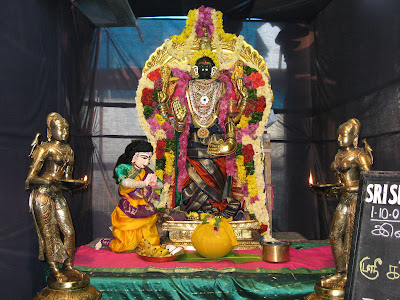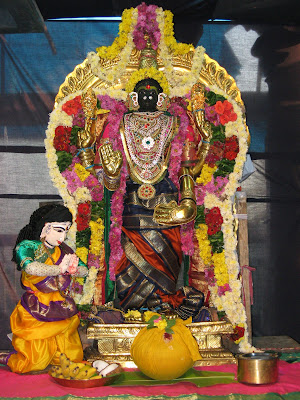Memory is unpredictable . One never really knows what we will remember and what we will forget. Which is why nostalgia arrives in unpredictable waves, highlighting something and skimming over others. Recently, I have found myself thinking of how memory works, as I was assailed by nostalgia over a trip to Varanasi, a city I prefer to think of, as Kashi. The nostalgia hit right as we landed at Varanasi airport. The last time I was here, it was 1988, I was 13 years old, the airport was brand new… regular flights hadn’t started yet (I think) … flights landed about once a week, and for the rest of the time, everything was open to those of us who lived in the airport quarters nearby. There were fields everywhere, vast expanses of green… I have vague memories of corn and sugarcane… and being overwhelmed by the vastness of the fields (this was the first time I was in such close proximity to them), and the warm hospitality of complete strangers who lived and worked amidst these fields. I h...
It is just the 2nd day of Navaratri, and already Samhith is looking forward to our temple visit. He is normally bored in the temple, and runs around, troubling everyone, but now, the daily decoration seems to be exciting him. He looks forward to the evening, and keeps asking whether it is time to visit the temple.
This second day of Navaratri, the temple priests had made a wonderful image of GARBARAKSHAMBIGAI, as she is seen at the Thirukkarugavur temple near Thanjavur.
Garbharakshambigai, or Karu Kaatha Nayaki as she is known in Tamil, represents the One who protected the Womb. The story behind this temple is as follows – Nidhruva Maharshi and his wife Vedhika were ardent devotees of Shiva and by the grace of the Lord, Vedhika became pregnant. Once, when her husband was out, tired after all her household chores, she lay down to rest, and fell asleep. The rishi Urdhvapada arrived at this time, and asked for alms, which she did not hear, being fast asleep. Not understanding her situation, the rishi cursed her to be afflicted with a foul disease, which also affected the foetus. When she prayed to Parvati, the goddess appeared and transferred the foetus to a pot where she herself nurtured it till it was fully grown. When the sage returned, he was overwhelmed, and prayed that the goddess must reside at that place and protect the womb of anyone who prayed to her. Till this day, it is said that no one in the village has a miscarriage or an abortion. She is prayed to by devotees seeking a child, and also for safe childbirth.
The temple to Garbharakshambigai is at Thirukkarugavur, 22 Kms from Kumbakonam and 7Kms from Papanasam. The main deity in this temple is Lord Shiva, known as Mullai Vana Nathar, or the Lord of the forest of Jasmines. This lingam is a swayambhu, which appeared in forest of Jasmine creepers, and was found covered with the creepers. The imprints of these creepers can be seen on the lingam.
This temple is one among the Pancha Aranya Sthalams – five temples situated amidst forests. It is considered auspicious to visit all the five temples, situated within a radius of 15Kms from this one, in one day. The Thirukkarugavur temple is the central one, to be visited early in the morning between 5:30 and 6AM. The second temple is at Avalivanallur, about 13 Kms from Alangudi (famous as one of the Navagraha Sthalams). This temple is to be visited in the morning between 9:30 and 10:00 AM. The third temple is at Haridwaramangalam, 22Kms from Kumbakonam and 10Kms West of Alangudi, and is to be visited between 11:00AM and Noon. The fourth temple is the one at Alangudi, 17Kms South of Kumbakonam, 35 Kms East of Thanjavur, and is to be visited between 5:30 and 6:00PM. The fifth and final temple is at Thirukkollambudhoor, 7Kms East of Alangudi on the road to Thiruvarur, and is to be visited between 8:30 and 9:00 PM.
Well, this brings me to the end of today’s post. Looking forward to getting back to all of you with more news of Navaratri celebrations…………..
This second day of Navaratri, the temple priests had made a wonderful image of GARBARAKSHAMBIGAI, as she is seen at the Thirukkarugavur temple near Thanjavur.
 |
| From Miscellaneous |
Garbharakshambigai, or Karu Kaatha Nayaki as she is known in Tamil, represents the One who protected the Womb. The story behind this temple is as follows – Nidhruva Maharshi and his wife Vedhika were ardent devotees of Shiva and by the grace of the Lord, Vedhika became pregnant. Once, when her husband was out, tired after all her household chores, she lay down to rest, and fell asleep. The rishi Urdhvapada arrived at this time, and asked for alms, which she did not hear, being fast asleep. Not understanding her situation, the rishi cursed her to be afflicted with a foul disease, which also affected the foetus. When she prayed to Parvati, the goddess appeared and transferred the foetus to a pot where she herself nurtured it till it was fully grown. When the sage returned, he was overwhelmed, and prayed that the goddess must reside at that place and protect the womb of anyone who prayed to her. Till this day, it is said that no one in the village has a miscarriage or an abortion. She is prayed to by devotees seeking a child, and also for safe childbirth.
 |
| From Miscellaneous |
The temple to Garbharakshambigai is at Thirukkarugavur, 22 Kms from Kumbakonam and 7Kms from Papanasam. The main deity in this temple is Lord Shiva, known as Mullai Vana Nathar, or the Lord of the forest of Jasmines. This lingam is a swayambhu, which appeared in forest of Jasmine creepers, and was found covered with the creepers. The imprints of these creepers can be seen on the lingam.
This temple is one among the Pancha Aranya Sthalams – five temples situated amidst forests. It is considered auspicious to visit all the five temples, situated within a radius of 15Kms from this one, in one day. The Thirukkarugavur temple is the central one, to be visited early in the morning between 5:30 and 6AM. The second temple is at Avalivanallur, about 13 Kms from Alangudi (famous as one of the Navagraha Sthalams). This temple is to be visited in the morning between 9:30 and 10:00 AM. The third temple is at Haridwaramangalam, 22Kms from Kumbakonam and 10Kms West of Alangudi, and is to be visited between 11:00AM and Noon. The fourth temple is the one at Alangudi, 17Kms South of Kumbakonam, 35 Kms East of Thanjavur, and is to be visited between 5:30 and 6:00PM. The fifth and final temple is at Thirukkollambudhoor, 7Kms East of Alangudi on the road to Thiruvarur, and is to be visited between 8:30 and 9:00 PM.
Well, this brings me to the end of today’s post. Looking forward to getting back to all of you with more news of Navaratri celebrations…………..
Comments
Post a Comment
Thanks so much for stopping by. Please leave a comment for me so that I will know you have been here....